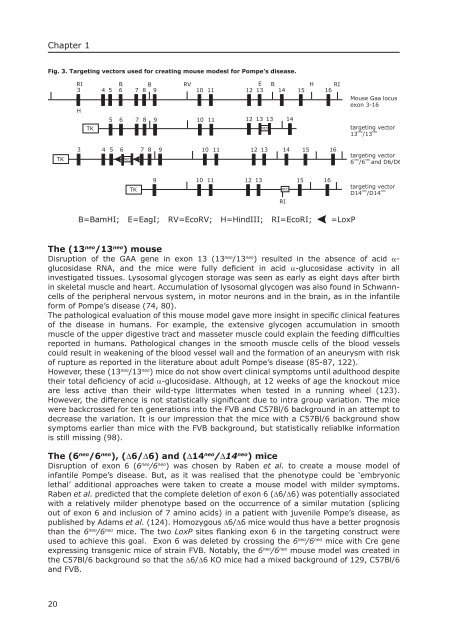Pompe's disease - RePub - Erasmus Universiteit Rotterdam
Pompe's disease - RePub - Erasmus Universiteit Rotterdam
Pompe's disease - RePub - Erasmus Universiteit Rotterdam
You also want an ePaper? Increase the reach of your titles
YUMPU automatically turns print PDFs into web optimized ePapers that Google loves.
Chapter 1<br />
Fig. 3. Targeting vectors used for creating mouse modesl for Pompe’s <strong>disease</strong>.<br />
20<br />
TK<br />
RI<br />
3<br />
H<br />
TK<br />
4<br />
B B<br />
RV<br />
5 6 7 8 9 10 11<br />
5 6 7 8 9 10 11<br />
E<br />
12 13<br />
B<br />
H RI<br />
14 15 16<br />
12 13 13 14<br />
3 4 5 6 7 8 9 10 11 12 13 14 15 16<br />
NEO<br />
TK<br />
9 10 11 12 13 15 16<br />
B=BamHI; E=EagI; RV=EcoRV; H=HindIII; RI=EcoRI; =LoxP<br />
NEO<br />
NEO<br />
RI<br />
Mouse Gaa locus<br />
exon 3-16<br />
targeting vector<br />
13 neo<br />
/13 neo<br />
targeting vector<br />
6 neo<br />
/6 neo<br />
and D6/D6<br />
targeting vector<br />
D14 neo<br />
/D14 neo<br />
The (13 neo /13 neo ) mouse<br />
Disruption of the GAA gene in exon 13 (13 neo /13 neo ) resulted in the absence of acid αglucosidase<br />
RNA, and the mice were fully defi cient in acid α-glucosidase activity in all<br />
investigated tissues. Lysosomal glycogen storage was seen as early as eight days after birth<br />
in skeletal muscle and heart. Accumulation of lysosomal glycogen was also found in Schwanncells<br />
of the peripheral nervous system, in motor neurons and in the brain, as in the infantile<br />
form of Pompe’s <strong>disease</strong> (74, 80).<br />
The pathological evaluation of this mouse model gave more insight in specifi c clinical features<br />
of the <strong>disease</strong> in humans. For example, the extensive glycogen accumulation in smooth<br />
muscle of the upper digestive tract and masseter muscle could explain the feeding diffi culties<br />
reported in humans. Pathological changes in the smooth muscle cells of the blood vessels<br />
could result in weakening of the blood vessel wall and the formation of an aneurysm with risk<br />
of rupture as reported in the literature about adult Pompe’s <strong>disease</strong> (85-87, 122).<br />
However, these (13 neo /13 neo ) mice do not show overt clinical symptoms until adulthood despite<br />
their total defi ciency of acid α-glucosidase. Although, at 12 weeks of age the knockout mice<br />
are less active than their wild-type littermates when tested in a running wheel (123).<br />
However, the difference is not statistically signifi cant due to intra group variation. The mice<br />
were backcrossed for ten generations into the FVB and C57Bl/6 background in an attempt to<br />
decrease the variation. It is our impression that the mice with a C57Bl/6 background show<br />
symptoms earlier than mice with the FVB background, but statistically reliablke information<br />
is still missing (98).<br />
The (6 neo /6 neo ), (∆6/∆6) and (∆14 neo /∆14 neo ) mice<br />
Disruption of exon 6 (6 neo /6 neo ) was chosen by Raben et al. to create a mouse model of<br />
infantile Pompe’s <strong>disease</strong>. But, as it was realised that the phenotype could be ‘embryonic<br />
lethal’ additional approaches were taken to create a mouse model with milder symptoms.<br />
Raben et al. predicted that the complete deletion of exon 6 (∆6/∆6) was potentially associated<br />
with a relatively milder phenotype based on the occurrence of a similar mutation (splicing<br />
out of exon 6 and inclusion of 7 amino acids) in a patient with juvenile Pompe’s <strong>disease</strong>, as<br />
published by Adams et al. (124). Homozygous ∆6/∆6 mice would thus have a better prognosis<br />
than the 6 neo /6 neo mice. The two LoxP sites fl anking exon 6 in the targeting construct were<br />
used to achieve this goal. Exon 6 was deleted by crossing the 6 neo /6 neo mice with Cre gene<br />
expressing transgenic mice of strain FVB. Notably, the 6 neo /6 neo mouse model was created in<br />
the C57Bl/6 background so that the ∆6/∆6 KO mice had a mixed background of 129, C57Bl/6<br />
and FVB.

















